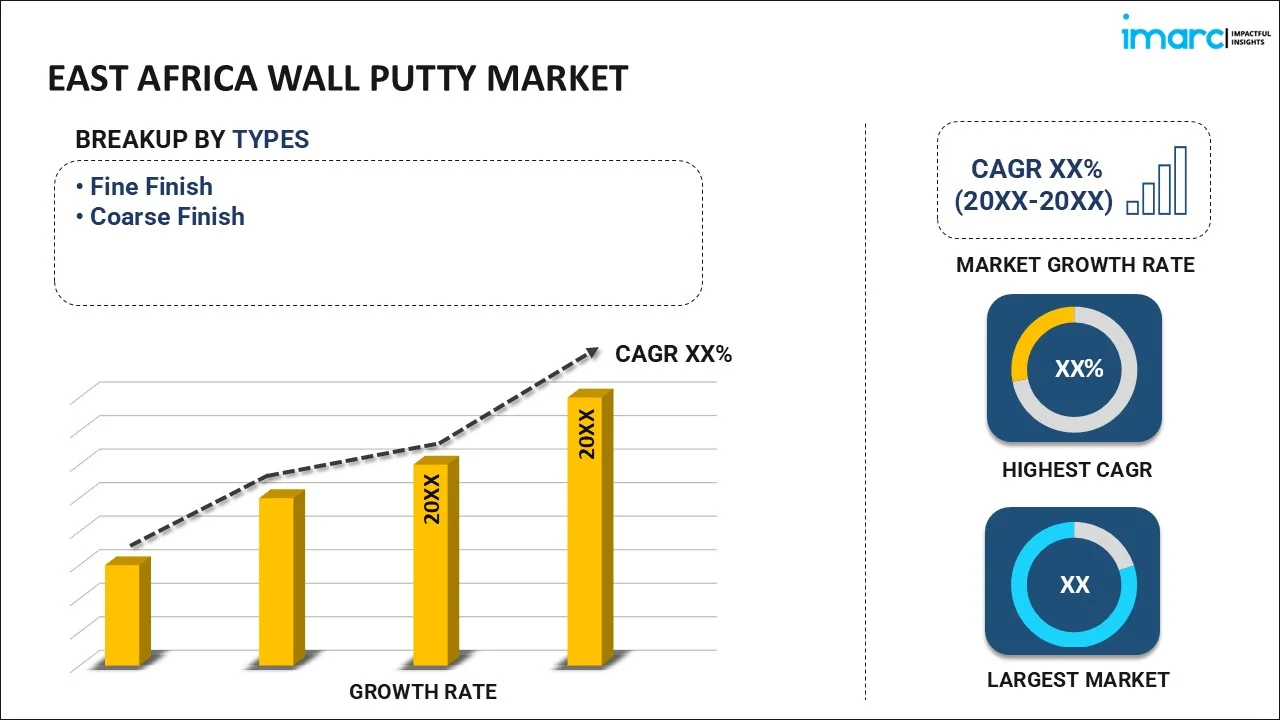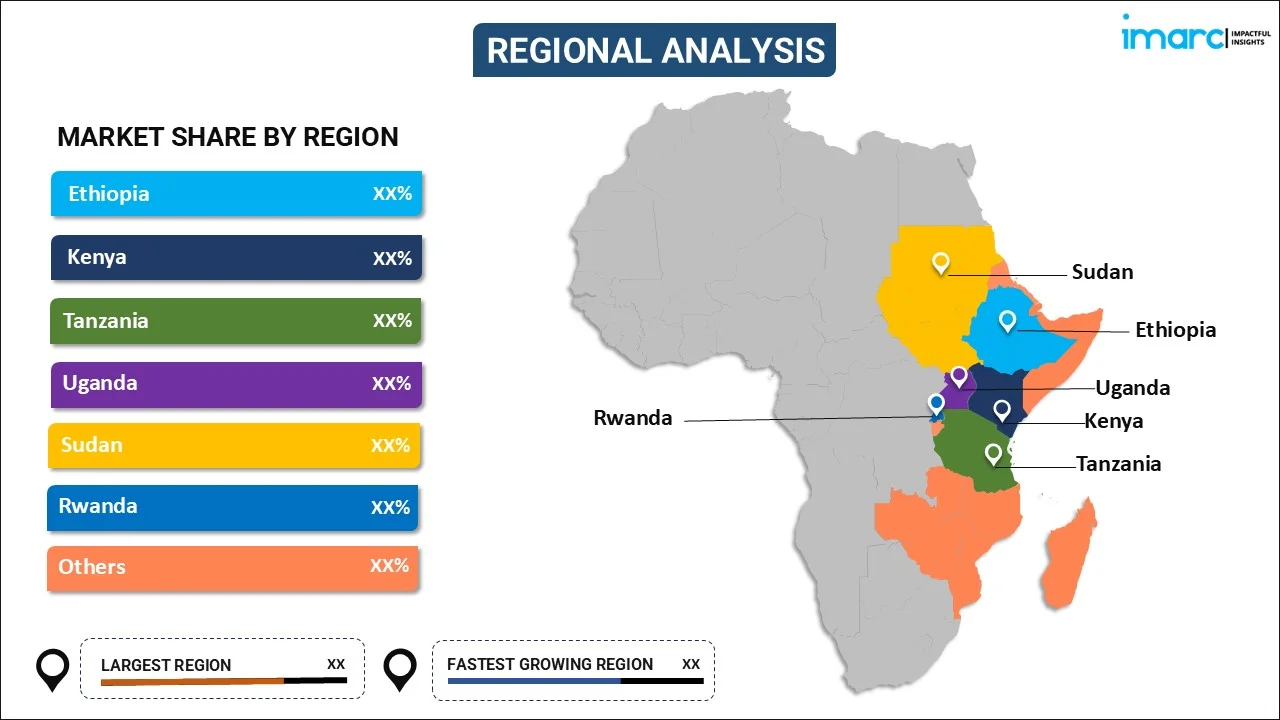
East Africa Wall Putty Market Report by Type (Fine Finish, Coarse Finish), Sector (Residential, Commercial, Industrial), and Region 2025-2033
Market Overview:
The East Africa white cement based wall putty market size reached 15,382.3 Tons in 2024. Looking forward, IMARC Group expects the market to reach 23,116.8 Tons by 2033, exhibiting a growth rate (CAGR) of 4.4% during 2025-2033.
|
Report Attribute
|
Key Statistics
|
|---|---|
|
Base Year
|
2024
|
|
Forecast Years
|
2025-2033
|
|
Historical Years
|
2019-2024
|
|
Market Size in 2024
|
15,382.3 Tons |
|
Market Forecast in 2033
|
23,116.8 Tons |
| Market Growth Rate 2025-2033 | 4.4% |
White cement wall putty is a white cement, mineral and polymer-based putty for use on cement concrete and provides bright, smooth and superior finish on plastered walls and ceiling. It can easily be applied on the exterior or interior of the walls. The growing construction industry in the East African countries is expected to boost the demand for white cement wall putty. Moreover, it exhibits excellent water-repellent and binding properties, good tensile adhesion strength, compression and flexural strength, eco-friendly nature, durability and low maintenance costs. Due to these properties, it is increasingly being preferred by the builders and the construction companies, thereby driving the market growth in the East African countries.
IMARC Group’s latest report provides a deep insight into the East Africa white cement based wall putty market covering all its essential aspects. This ranges from macro overview of the market to micro details of the industry performance, recent trends, key market drivers and challenges, SWOT analysis, Porter’s five forces analysis, value chain analysis, etc. This report is a must-read for entrepreneurs, investors, researchers, consultants, business strategists, and all those who have any kind of stake or are planning to foray into East Africa white cement based wall putty market in any manner.
Key Market Segmentation:
IMARC Group provides an analysis of the key trends in each sub-segment of the East Africa wall putty market report, along with forecasts at the regional and country level from 2025-2033. Our report has categorized the market based on type and sector.
Breakup by Type:

- Fine Finish
- Coarse Finish
Amongst these, fine finish represents the biggest segment, accounting for the largest market share.
Breakup by Sector:
- Residential
- Commercial
- Industrial
Residential sector currently accounts for the largest share in the East African white cement based wall putty market.
Breakup by Region:

- Ethiopia
- Kenya
- Tanzania
- Uganda
- Sudan
- Rwanda
- Others
The report has also provided a comprehensive analysis of all the major regional markets, which include Ethiopia, Kenya, Tanzania, Uganda, Sudan, Rwanda, and Others.
Competitive Landscape:
The report has also examined the competitive landscape of East Africa white cement based wall putty market.
Report Coverage:
| Report Features | Details |
|---|---|
| Base Year of the Analysis | 2024 |
| Historical Period | 2019-2024 |
| Forecast Period | 2025-2033 |
| Units | Million USD, Tons |
| Segment Coverage | Type, Sector, Region |
| Countries Covered | Ethiopia, Kenya, Tanzania, Uganda, Sudan, Rwanda, Others |
| Customization Scope | 10% Free Customization |
| Post-Sale Analyst Support | 10-12 Weeks |
| Delivery Format | PDF and Excel through Email (We can also provide the editable version of the report in PPT/Word format on special request) |
Key Questions Answered in This Report
The East Africa wall putty market reached a volume of 15,382.3 Tons in 2024.
We expect the East Africa wall putty market to exhibit a CAGR of 4.4% during 2025-2033.
The rising adoption of wall putty in the construction sector, as it is eco-friendly, highly durable, requires low maintenance cost, etc., is primarily catalyzing the East Africa wall putty market.
The sudden outbreak of the COVID-19 pandemic had led to the implementation of stringent lockdown regulations across the region resulting in the temporary halt in numerous construction activities, thereby limiting the demand for wall putty.
Based on the type, the East Africa wall putty market has been segmented into fine finish and coarse finish. Currently, fine finish holds the majority of the total market share.
Based on the sector, the East Africa wall putty market can be divided into residential, commercial, and industrial. Among these, the residential sector currently exhibits a clear dominance in the market.
On a regional level, the market has been classified into Ethiopia, Kenya, Tanzania, Uganda, Sudan, Rwanda, and Others.
Need more help?
- Speak to our experienced analysts for insights on the current market scenarios.
- Include additional segments and countries to customize the report as per your requirement.
- Gain an unparalleled competitive advantage in your domain by understanding how to utilize the report and positively impacting your operations and revenue.
- For further assistance, please connect with our analysts.
 Inquire Before Buying
Inquire Before Buying
 Speak to an Analyst
Speak to an Analyst
 Request Brochure
Request Brochure
 Request Customization
Request Customization




.webp)




.webp)












